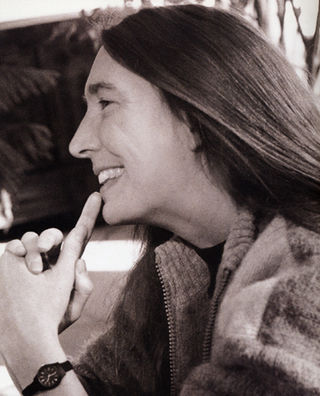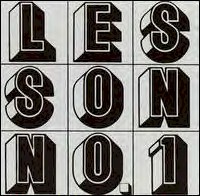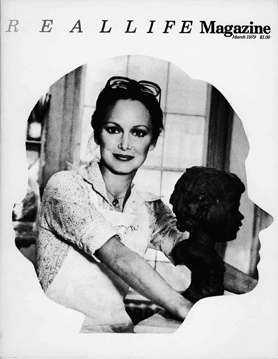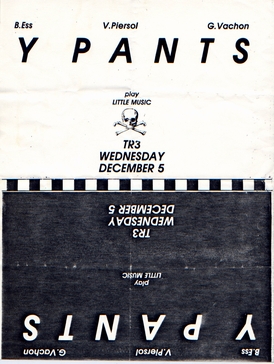No wave was an avant-garde music genre and visual art scene that emerged in the late 1970s in Downtown New York City. The term was a pun based on the rejection of commercial new wave music. Reacting against punk rock's recycling of rock and roll clichés, no wave musicians instead experimented with noise, dissonance, and atonality, as well as non-rock genres like free jazz, funk, and disco. The scene often reflected an abrasive, confrontational, and nihilistic world view.

Glenn Branca was an American avant-garde composer, guitarist, and luthier. Known for his use of volume, alternative guitar tunings, repetition, droning, and the harmonic series, he was a driving force behind the genres of no wave, totalism and noise rock. Branca received a 2009 Foundation for Contemporary Arts Grants to Artists Award.
Noise music is a genre of music that is characterised by the expressive use of noise. This type of music tends to challenge the distinction that is made in conventional musical practices between musical and non-musical sound. Noise music includes a wide range of musical styles and sound-based creative practices that feature noise as a primary aspect.

Jenny Holzer is an American neo-conceptual artist, based in Hoosick, New York. The main focus of her work is the delivery of words and ideas in public spaces and includes large-scale installations, advertising billboards, projections on buildings and other structures, and illuminated electronic displays.

Rhys Chatham is an American composer, guitarist, trumpet player, multi-instrumentalist, primarily active in avant-garde and minimalist music. He is best known for his "guitar orchestra" compositions. He has lived in France since 1987.
Barbara Kruger is an American conceptual artist and collagist associated with the Pictures Generation. She is most known for her collage style that consists of black-and-white photographs, overlaid with declarative captions, stated in white-on-red Futura Bold Oblique or Helvetica Ultra Condensed text. The phrases in her works often include pronouns such as "you", "your", "I", "we", and "they", addressing cultural constructions of power, identity, consumerism, and sexuality. Kruger's artistic mediums include photography, sculpture, graphic design, architecture, as well as video and audio installations.
Robert Kirby is an American cartoonist, known for his long-running syndicated comic Curbside – which ran in the gay and alternative presses from 1991 to 2008 – and other works focusing on queer characters and community, including Strange Looking Exile, Boy Trouble, THREE, and QU33R.

Virtual art is a term for the virtualization of art, made with the technical media developed at the end of the 1980s. These include human-machine interfaces such as visualization casks, stereoscopic spectacles and screens, digital painting and sculpture, generators of three-dimensional sound, data gloves, data clothes, position sensors, tactile and power feed-back systems, etc. As virtual art covers such a wide array of mediums it is a catch-all term for specific focuses within it. Much contemporary art has become, in Frank Popper's terms, virtualized.

Lesson No. 1 is the debut solo EP by American avant-garde musician Glenn Branca. It was released in March 1980 on 99 Records.

Noise Fest was an influential festival of no wave noise music performances curated by Thurston Moore of Sonic Youth at the New York City art space White Columns in June 1981. Sonic Youth made their first live appearances at this show.

Redtape was one of the East Village zines of artistic expression published between 1980 and 1992. Published and edited by Michael Carter, Red Tape Magazine featured comics, fiction, poetry, fine art, graphic art and photography; thereby chronicling issues and feelings central the post-punk East Village art scene during the 80’s. These included gentrification, the threat of nuclear war, sexual freedom, squatting, AIDS, no wave art and music, and the prevalence of hard drugs.

REALLIFE Magazine was a publication featuring written and visual material by and about young artists that was co-founded and published by artist Thomas Lawson and writer Susan Morgan between 1979 and 1994. It served as a clearing house for new ideas and examinations of mass media and art, while chronicling New York's developing postmodern alternative art scene. It was strongly associated with The Pictures Generation group of artists.
The Pictures Generation, 1974–1984 was an exhibition at The Metropolitan Museum of Art in New York City that ran from April 29 – August 2, 2009. The exhibition took its name from Pictures, a 1977 five person group show organized by art historian and critic Douglas Crimp (1944–2019) at New York City's Artists Space gallery. The artists exhibited from September 24 to October 29, 1977 were Troy Brauntuch, Jack Goldstein, Sherrie Levine, Robert Longo and Philip Smith.

Y Pants were an American all-female no wave band from New York City active from 1979 to 1982. The trio, made up of photographer/musician Barbara Ess, visual artist Virginia Piersol, and filmmaker Gail Vachon, developed a unique sound via their acoustic toy instrumentation of toy piano, ukulele and a paper-headed Mickey Mouse drum kit, augmented by electric bass guitar, Casio keyboards and various low-tech effects.

Arleen Schloss is an American performance artist, video/film artist, sound poet, director and curator of the lower Manhattan art, video, performance art and music scenes. Schloss began her influence through A's – an interdisciplinary loft space in New York City that became a hub for music, exhibitions, performance art, films and videos. Artists and performers such as Jean-Michel Basquiat, Eric Bogosian, Phoebe Legere, Sonic Youth, Liquid Liquid, Carolee Schnemann, Alan Vega, Martin Wong, and Aei Wei Wei performed, exhibited and got their start at A's. In the 1990s A's became A's Wave where website works and other forms of digital media were shown.

Barbara Ess was an American pinhole camera photographer, No Wave musician and Just Another Asshole editor. She taught photography at Bard College since 1997; who in 2024, along with the Schwartz family, has established an annual award to assist Bard College photography students in need called The Barbara Ess Fund for Artistic Expression in Photography.
Mitch Corber is a New York City neo-Beat poet, an eccentric performance artist, and no wave videographer known for his rapid whimsically comical montage and collage style. He has been associated with Collaborative Projects, Inc., participated in Public Arts International/Free Speech and The Times Square Show, and is creator-director of cable TV long-running weekly series Poetry Thin Air in New York City and its on-line poetry/video archive. He has worked closely with ABC No Rio, Colab TV and the MWF Video Club and his audio art have been published on Tellus Audio Cassette Magazine three times. He is a recipient of a NY Foundation for the Arts Fellowship grant (1987) in the field of emerging artforms.
Tricia Collins is an American art critic, art gallerist and curator of contemporary art. She was half of the curatorial team Collins & Milazzo, with Richard Milazzo, who together co-published and co-edited Effects : Magazine for New Art Theory from 1982 to 1984. She later ran the art galleries Grand Salon, Tricia Collins Grand Salon, and Tricia Collins Contemporary Art in New York City until the year 2000.
Effects: Magazine for New Art Theory was an American arts magazine. It was co-published and co-edited by Tricia Collins and Richard Milazzo from 1983 to 1986 in New York City. All issues were offset-printed staple bound 27.7 x 21.3 cm.

The Times Square Show was an influential collaborative, self-curated, and self-generated art exhibition held by New York artists' group Colab in Times Square in a shuttered massage parlor at 201 W. 41st and 7th Avenue during the entire month of June in 1980. The Times Square Show was largely inspired by the more radical Colab show The Real Estate Show, but unlike it, was open 24 hours a day, 7 days a week, in what was then a Times Square full of porno theaters, peep shows, and red light establishments. In addition to experimental painting and sculpture, the exhibition incorporated music, fashion, and an ambitious program of performance and video. For many artists the exhibition served as a forum for the exchange of ideas, a testing-ground for social-directed figurative work in progress, and a catalyst for exploring new political-artistic directions.













